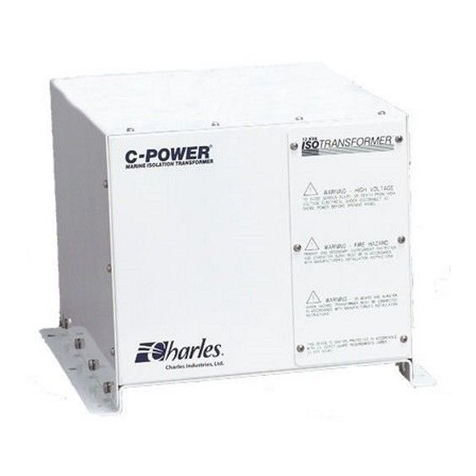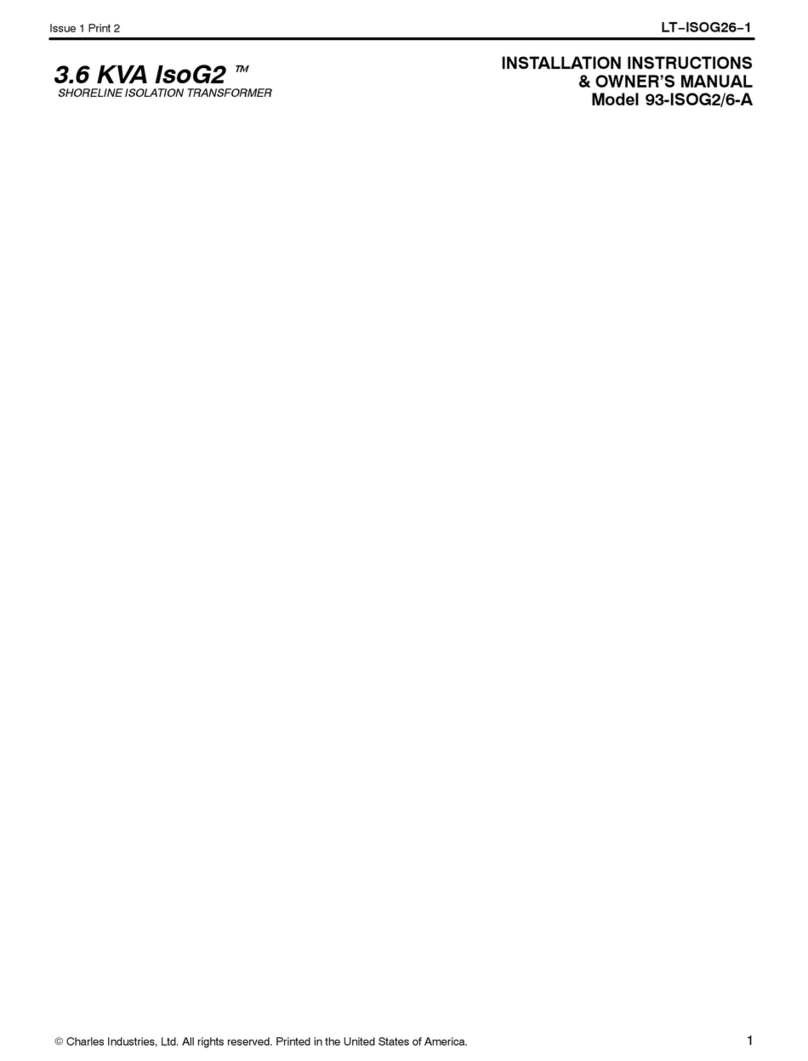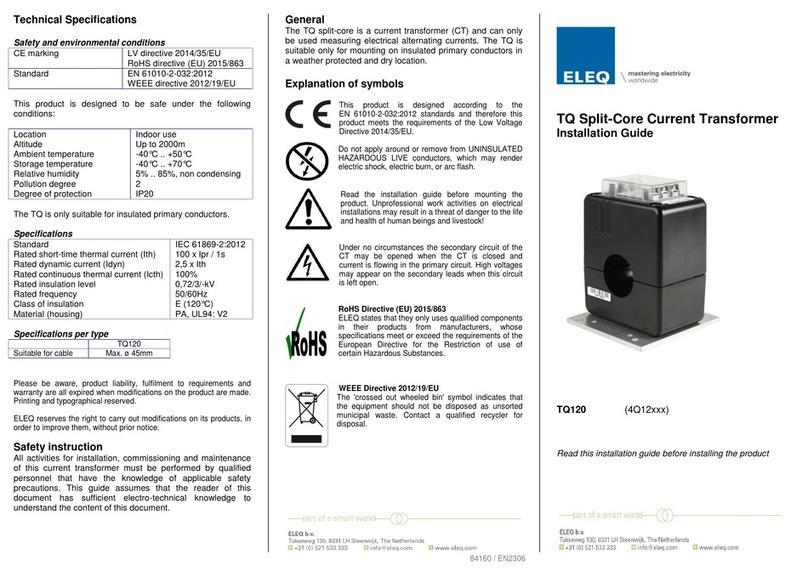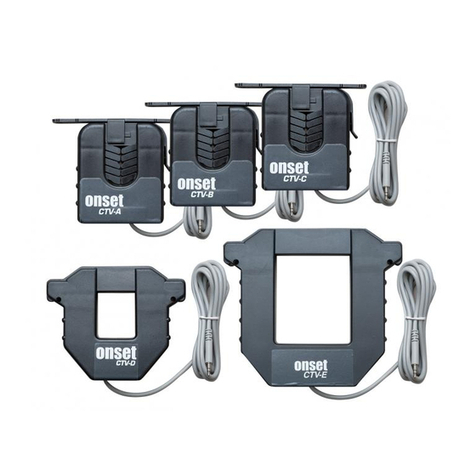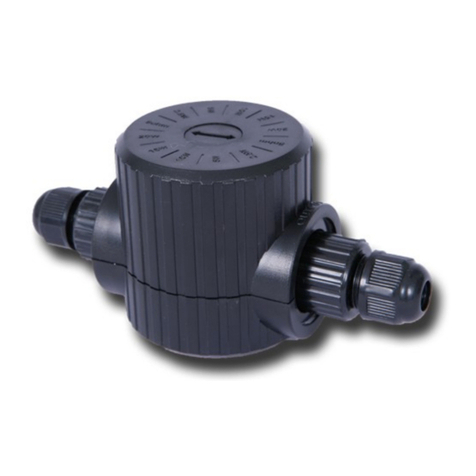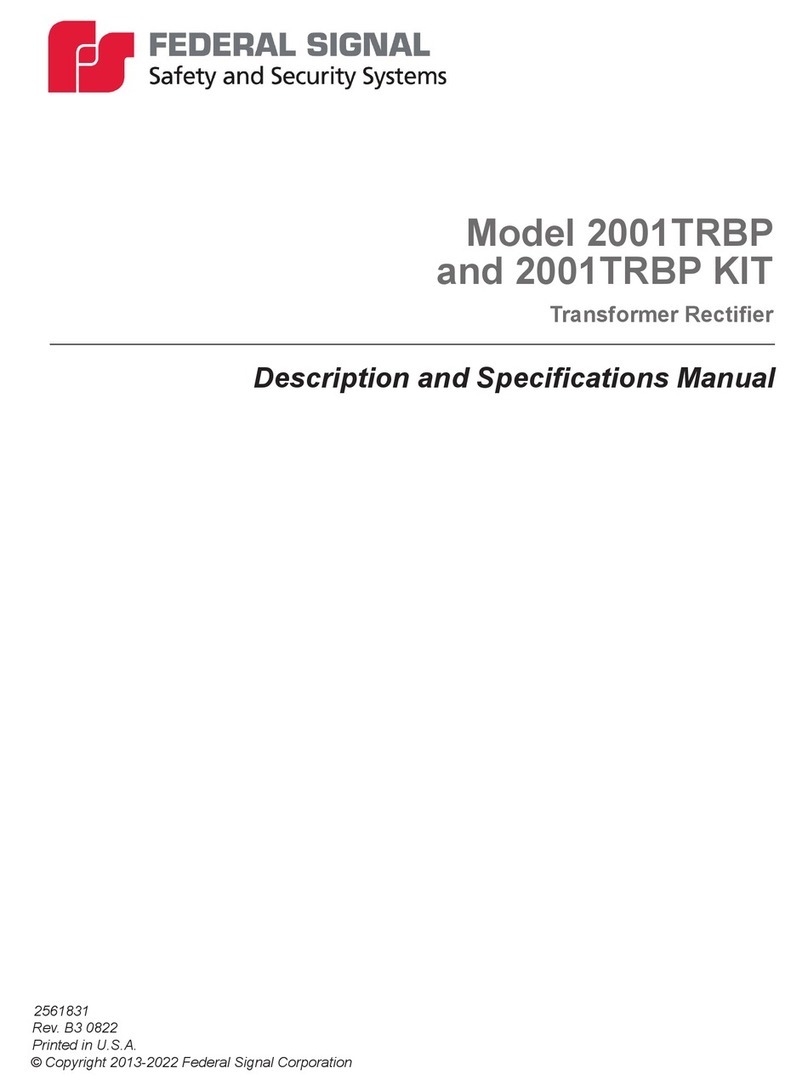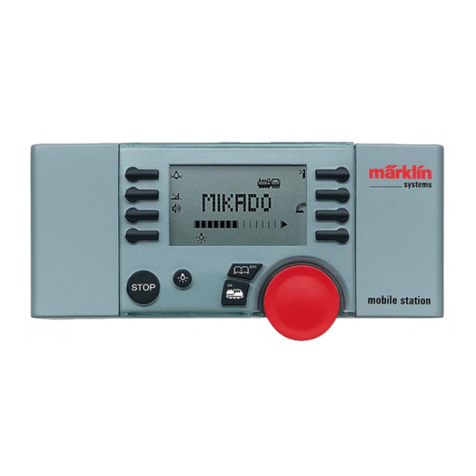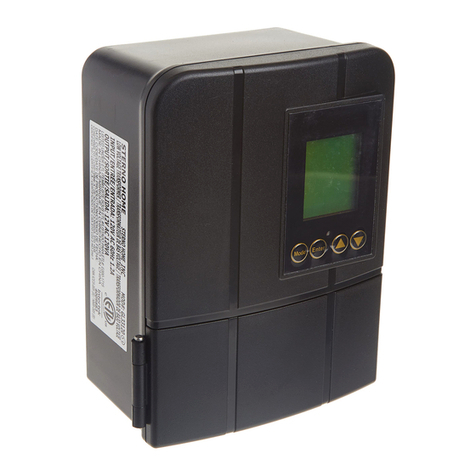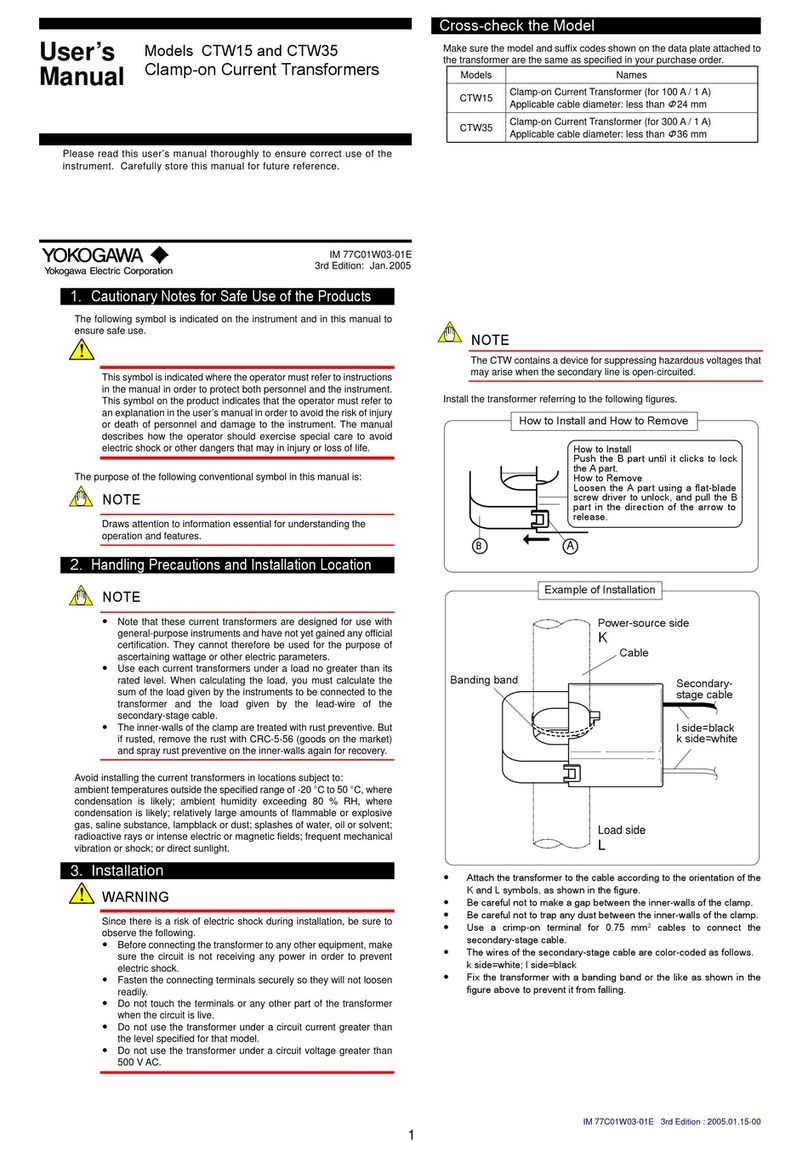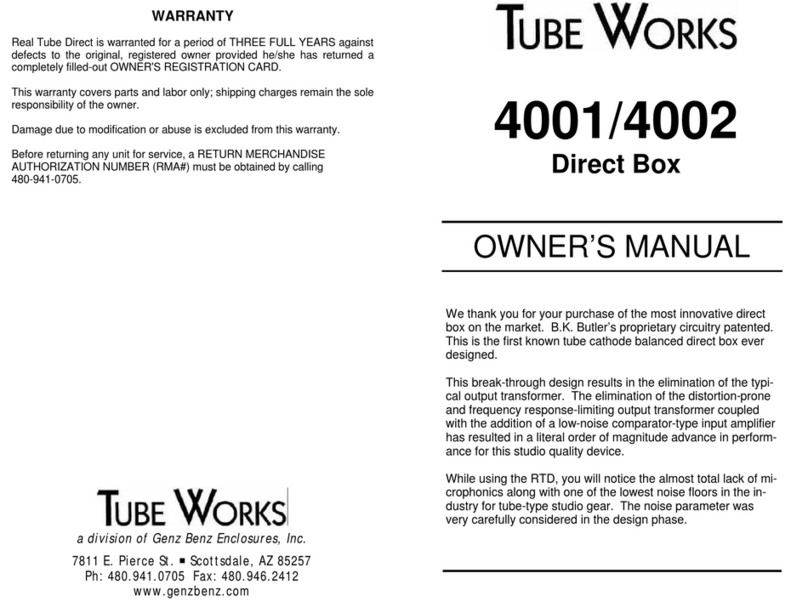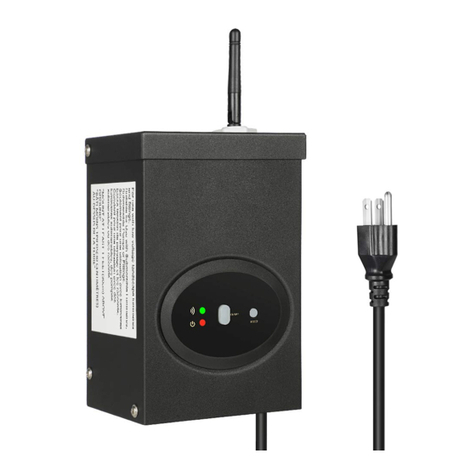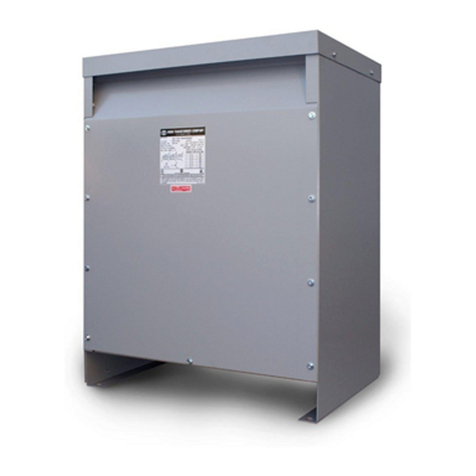Charles Isotransformer 93-IXFMR3/6-A Service manual

Issue 1 Print 2 LT–IXFMR36–1
Page 1 of 15
Charles Industries, Ltd. All rights reserved. Printed in the United States of America.
3.6 KVA IsotransformertINSTALLATION INSTRUCTIONS
& OWNER’S MANUAL
Model 93–IXFMR3/6–A
SHORELINE ISOLATION TRANSFORMER
Marine Group

LT–IXFMR36–1
2
Contents
INTRODUCING... 3.6 KVA ISOTRANSFORMERt 3. . . . . . . . . . . . . . . . . . . . . . . . . . . . . . . . . . . . . . . . . . . . . . . . . . . . .
Warranty/Registration 3. . . . . . . . . . . . . . . . . . . . . . . . . . . . . . . . . . . . . . . . . . . . . . . . . . . . . . . . . . . . . . . . . . . . . . . . .
Manual Purpose 3. . . . . . . . . . . . . . . . . . . . . . . . . . . . . . . . . . . . . . . . . . . . . . . . . . . . . . . . . . . . . . . . . . . . . . . . . . . . . .
APPLICATION 3. . . . . . . . . . . . . . . . . . . . . . . . . . . . . . . . . . . . . . . . . . . . . . . . . . . . . . . . . . . . . . . . . . . . . . . . . . . . . . . . . . . .
IMPORTANT SAFETY INSTRUCTIONS 3. . . . . . . . . . . . . . . . . . . . . . . . . . . . . . . . . . . . . . . . . . . . . . . . . . . . . . . . . . . . .
Warnings 3. . . . . . . . . . . . . . . . . . . . . . . . . . . . . . . . . . . . . . . . . . . . . . . . . . . . . . . . . . . . . . . . . . . . . . . . . . . . . . . . . . . .
Installation Precaution 4. . . . . . . . . . . . . . . . . . . . . . . . . . . . . . . . . . . . . . . . . . . . . . . . . . . . . . . . . . . . . . . . . . . . . . . .
Environmental Precaution 4. . . . . . . . . . . . . . . . . . . . . . . . . . . . . . . . . . . . . . . . . . . . . . . . . . . . . . . . . . . . . . . . . . . . .
Application Precaution 4. . . . . . . . . . . . . . . . . . . . . . . . . . . . . . . . . . . . . . . . . . . . . . . . . . . . . . . . . . . . . . . . . . . . . . . .
Damaged Unit Precaution 4. . . . . . . . . . . . . . . . . . . . . . . . . . . . . . . . . . . . . . . . . . . . . . . . . . . . . . . . . . . . . . . . . . . . .
Disassembly Precaution 4. . . . . . . . . . . . . . . . . . . . . . . . . . . . . . . . . . . . . . . . . . . . . . . . . . . . . . . . . . . . . . . . . . . . . .
INSTALLING THE ISOTRANSFORMER 5. . . . . . . . . . . . . . . . . . . . . . . . . . . . . . . . . . . . . . . . . . . . . . . . . . . . . . . . . . . . .
Choosing an Electrical Wiring Method 5. . . . . . . . . . . . . . . . . . . . . . . . . . . . . . . . . . . . . . . . . . . . . . . . . . . . . . . . .
Wired as an Isolation Transformer 6. . . . . . . . . . . . . . . . . . . . . . . . . . . . . . . . . . . . . . . . . . . . . . . . . . . . . . . . . . . . .
Wired as a Polarization Transformer 8. . . . . . . . . . . . . . . . . . . . . . . . . . . . . . . . . . . . . . . . . . . . . . . . . . . . . . . . . . .
Choosing Mounting Location 9. . . . . . . . . . . . . . . . . . . . . . . . . . . . . . . . . . . . . . . . . . . . . . . . . . . . . . . . . . . . . . . . . .
Choosing Mounting Hardware 9. . . . . . . . . . . . . . . . . . . . . . . . . . . . . . . . . . . . . . . . . . . . . . . . . . . . . . . . . . . . . . . . .
Mounting the IsoTransformer 10. . . . . . . . . . . . . . . . . . . . . . . . . . . . . . . . . . . . . . . . . . . . . . . . . . . . . . . . . . . . . . . . .
Choosing the Appropriate Wire Type and Gauge 10. . . . . . . . . . . . . . . . . . . . . . . . . . . . . . . . . . . . . . . . . . . . . . .
Choosing Electrical Wiring Hardware 10. . . . . . . . . . . . . . . . . . . . . . . . . . . . . . . . . . . . . . . . . . . . . . . . . . . . . . . . .
Overcurrent Protection 11. . . . . . . . . . . . . . . . . . . . . . . . . . . . . . . . . . . . . . . . . . . . . . . . . . . . . . . . . . . . . . . . . . . . . . .
Making IsoTransformer Connections 11. . . . . . . . . . . . . . . . . . . . . . . . . . . . . . . . . . . . . . . . . . . . . . . . . . . . . . . . . .
Securing Covers 14. . . . . . . . . . . . . . . . . . . . . . . . . . . . . . . . . . . . . . . . . . . . . . . . . . . . . . . . . . . . . . . . . . . . . . . . . . . . .
Applying Power 14. . . . . . . . . . . . . . . . . . . . . . . . . . . . . . . . . . . . . . . . . . . . . . . . . . . . . . . . . . . . . . . . . . . . . . . . . . . . .
OPERATING THE ISOTRANSFORMER 14. . . . . . . . . . . . . . . . . . . . . . . . . . . . . . . . . . . . . . . . . . . . . . . . . . . . . . . . . . . .
Safety First 14. . . . . . . . . . . . . . . . . . . . . . . . . . . . . . . . . . . . . . . . . . . . . . . . . . . . . . . . . . . . . . . . . . . . . . . . . . . . . . . . . .
Proper Operation 14. . . . . . . . . . . . . . . . . . . . . . . . . . . . . . . . . . . . . . . . . . . . . . . . . . . . . . . . . . . . . . . . . . . . . . . . . . . .
MAINTAINING THE ISOTRANSFORMER 14. . . . . . . . . . . . . . . . . . . . . . . . . . . . . . . . . . . . . . . . . . . . . . . . . . . . . . . . . . .
TROUBLESHOOTING 14. . . . . . . . . . . . . . . . . . . . . . . . . . . . . . . . . . . . . . . . . . . . . . . . . . . . . . . . . . . . . . . . . . . . . . . . . . . .
WARRANTY & CUSTOMER SERVICE 14. . . . . . . . . . . . . . . . . . . . . . . . . . . . . . . . . . . . . . . . . . . . . . . . . . . . . . . . . . . . .
Warranty 14. . . . . . . . . . . . . . . . . . . . . . . . . . . . . . . . . . . . . . . . . . . . . . . . . . . . . . . . . . . . . . . . . . . . . . . . . . . . . . . . . . . .
Warranty Service and Repair 14. . . . . . . . . . . . . . . . . . . . . . . . . . . . . . . . . . . . . . . . . . . . . . . . . . . . . . . . . . . . . . . . .
Customer Service 15. . . . . . . . . . . . . . . . . . . . . . . . . . . . . . . . . . . . . . . . . . . . . . . . . . . . . . . . . . . . . . . . . . . . . . . . . . . .
SPECIFICATIONS 15. . . . . . . . . . . . . . . . . . . . . . . . . . . . . . . . . . . . . . . . . . . . . . . . . . . . . . . . . . . . . . . . . . . . . . . . . . . . . . .

LT–IXFMR36–1
3
Charles Industries, Ltd. All rights reserved. Printed in the United States of America.
INTRODUCING... 3.6 KVA ISOTRANSFORMER
Thank you for purchasing the 3.6 KVA IsoTransformer! Your IsoTransformer completely isolates input power
from output power providing an improved degree of safety and reducing galvanic current corrosion due to the di-
rect connection to AC shore power.
Warranty/Registration
Before proceeding, complete and mail back the Warranty Registration card.
Manual Purpose
With your personal safety in mind, this manual lists important safety precautions first, then covers installation,
operation, maintenance, troubleshooting, warranty, and customer service information.
APPLICATION
The 3.6 KVA IsoTransformer is a shoreline isolation transformer intended for boats with 30 amp/120 volt service.
Properly installed it will electrically isolate AC shore power from the boat’s AC power system reducing galvanic
current corrosion due to the AC shore power connection.
The boat’s electrical system and grounding conductor are not actually connected to the shoreside system when
you use the 3.6 KVA IsoTransformer as an isolation transformer. Power is transferred from the shoreside electri-
cal system to the boat’s electrical system by magnetic coupling. This means there is no direct electrical connec-
tion between the earth-grounded shore AC power and boat AC power systems. The shore grounding conductor is
connected to a shield that is wound between the primary (shore) and secondary (boat) transformer windings. This
shield assures isolation on the boat by providing a protective layer between primary and secondary windings with-
in the transformer. In the unlikely event of a breakdown within the transformer, the shield can withstand the fault
current of a properly sized shore supply circuit breaker long enough for the breaker to trip. In addition, by ground-
ing one leg of the transformer secondary (X2) on board the boat a “neutral” ground is established for the vessel’s
electrical system. When using the transformer, shoreline polarity is no longer a consideration and a shoreline po-
larity device is not necessary.
IMPORTANT SAFETY INSTRUCTIONS
SAVE THESE INSTRUCTIONS. This manual contains important safety and operating instructions
for the IsoTransformer. Read the entire manual before usage. Also read all instructions and cautions for and
on the IsoTransformer.
Warnings
To avoid serious injury or death from high voltage electrical shock disconnect AC shore power before
opening panel.
WARNING — HIGH VOLTAGE
Primary overcurrent protection and conductor sizing must be in accordance with manufacturer’s
installation instructions.
WARNING — FIRE HAZARD
On board and in-water shock hazard. Transformer must be connected in accordance with
manufacturer’s installation instructions.
WARNING
Do not store equipment on or next to transformer. This unit is designed to operate hot and must have
free air flow to prevent over heating or charring of adjacent material.
WARNING — FIRE HAZARD

LT–IXFMR36–1
4Charles Industries, Ltd. All rights reserved. Printed in the United States of America.
Cord grip connectors must be used to prevent wires from chafing on the metal case and causing an
electrical short. See installation instructions for suitable connector types or call Charles Marine
Products to order a connector kit.
WARNING —ELECTRICAL SHOCK AND FIRE HAZARD
Installation Precaution
Boat wiring is a complex task that can cause shock, corrosion and other hazards if not done properly by trained,
experienced personnel. For more information on this subject contact the American Boat and Yacht Council
(ABYC) or see the standards and regulations below:
American Boat and Yacht Council
E-8 “Alternating Current (AC) Electrical Systems
on Boats”
3069 Solomon’s Island Road
Edgewater, MD 21037
Telephone: 410.956.1050
FAX: 410.456.2737
NFPA Standard 302.
“Pleasure and Commercial Motor Craft”National Fire Protection Association
1 Batterymarch Park
P.O. Box 9101
Quincy, MA 02269-9401
Telephone: 800.344.3555
Rules and Regulations for Recreational Boats Excerpts from the United States Code (USC) and the
Code of Federal Regulations (CFR) (U.S. Coast Guard
Regulations) are available from the American Boat
and Yacht Council listed above.
Note: Installation of the IsoTransformer must be made in accordance with all applicable standards and regula-
tions.
Environmental Precaution
The IsoTransformer is intended for installation inside an engine room or elsewhere inside the boat. Make sure
that the location will not subject the unit to rain, snow, excessive moisture, or excessive heat.
This device is ignition protected in accordance with U.S. Coast Guard regulations under 33 CFR
183.410.
NOTICE
Application Precaution
The IsoTransformer is intended for hard-wired, permanent, on-board applications. Use of attachments not recom-
mended or sold by Charles Marine Products may result in risk of fire, electrical shock or personal injury.
Damaged Unit Precaution
Do not operate the IsoTransformer if it has received a sharp blow, been dropped, immersed in water or otherwise
damaged. See the section in this manual on Warranty & Customer Service for repair information.
Disassembly Precaution
Do not disassemble the IsoTransformer. See the sections in this manual on Maintaining the IsoTransformer, Trou-
bleshooting the IsoTransformer and Warranty & Customer Service.

LT–IXFMR36–1
5
Charles Industries, Ltd. All rights reserved. Printed in the United States of America.
INSTALLING THE ISOTRANSFORMER
Choosing an Electrical Wiring Method
There are two wiring methods that can be used to install the IsoTransformer as an isolation transformer in accor-
dance with ABYC E-8 Alternating Current (AC) Electrical Systems on Boats. A third method, also in accordance
with ABYC E-8, can be used to install the IsoTransformer as a polarization transformer if desired. The third meth-
od is not preferred, because wiring the unit in the manner described circumvents the AC grounding conductor
isolation between shore and boat power and may require the use of a galvanic isolator to reduce galvanic corro-
sion.
Note: Figure 1, Figure 2 and Figure 3 are reprinted with permission from the American Boat and Yacht Council
(ABYC). To obtain the complete standard referenced or any other standards contact:
American Boat and Yacht Council: 3069 Solomon’s Island Road
Edgewater, MD 21037
Telephone: 410.956.1050
FAX: 410.456.2737

LT–IXFMR36–1
6Charles Industries, Ltd. All rights reserved. Printed in the United States of America.
Wired as an Isolation Transformer
The only difference between Method 1 and Method 2 is that in Method 2, a Ground Fault Protector (GFP) must
be used instead of just a circuit breaker, and the shore grounding conductor is not wired past the inlet of the boat.
Method 1 is most commonly used.
Note: This diagram does not illustrate a complete system. Refer to the appropriate ABYC text.
Isolation Transformer System with Single-Phase 120-Volt Input with Grounded Secondary. Shield Grounded
on Shore. Metal Case Grounded on the Boat. The green grounding wire from the shore inlet is connected to
the isolation transformer shield. The green grounding wire is connected to the shell of the power inlet which is
insulated from the hull of the boat.
The ungrounded and grounded shore current-carrying conductors are connected from the power inlet to the
primary winding of the isolation transformer through an overcurrent protection device which simultaneously
opens both current-carrying shore conductors. Fuses shall not be used in lieu of the simultaneous trip de-
vices.
120-Volt branch circuit breakers are permitted to use single-pole breakers in the ungrounded current-carrying
conductors.
The secondary of the isolation transformer is grounded (polarized) on the boat.
The boat grounding system (green) conductor is connected from the metal case of the isolation transformer to
all noncurrent-carrying parts of the boat’s AC electrical system including the engine negative terminal or its
bus without interposing switches or overcurrent protection devices.
ÉÉÉ
ÉÉÉ
ÉÉÉ
ÉÉÉ
ÉÉÉ
ÉÉÉ
Ungrounded Conductor (Black)
Grounded Neutral Conductor (White)
Grounding Conductor (Green)
Shore Connection
Shore Power Cable
Shore Power Cable Connector
2-Pole, 3-Wire Grounding
Type Plugs & Receptacles
Shore Side
Boat Side
Power Inlet
(Electrically insulated
from the Boat)
Main Shore Power
Disconnect
Circuit Breaker
Transformer Case
Encapsulated Single Phase
Isolation Transformer
To Engine Negative
Terminal or its Bus
Black
White
Green
120 VAC
Grounding
Type
Receptacle
120 VAC
Device
Branch
Circuit
Breaker
(Typical)
Transformer Shield
(Insulated from Case and Core)
Transformer Case
Ground Connection
Figure 1. Electrical Diagram –Method 1 (see Figure 5 for Wiring Connections)

LT–IXFMR36–1
7
Charles Industries, Ltd. All rights reserved. Printed in the United States of America.
Note: This diagram does not illustrate a complete system. Refer to the appropriate ABYC text.
Isolation Transformer System with Single-Phase 120-Volt Input with Ground Fault Protection and Grounded
Secondary. Shield and Metal Case Grounded on the Boat. The green grounding wire from the shore inlet is
not connected to the isolation transformer shield or metal case. The green grounding wire is connected to the
shell of the power inlet which is insulated from the hull of the boat.
The ungrounded and grounded shore current-carrying conductors are connected from the power inlet to the
primary winding of the isolation transformer through a ground fault protection device which simultaneously
opens both current-carrying shore conductors. Fuses shall not be used in lieu of the simultaneous trip devices.
120-Volt branch circuit breakers are permitted to use single-pole breakers in the ungrounded current-carrying
conductors.
The secondary of the isolation transformer is grounded (polarized) on the boat.
The boat grounding system (green) conductor is connected from the shield and metal case of the isolation
transformer to all noncurrent-carrying parts of the boat’s AC electrical system including the engine negative
terminal or its bus without interposing switches or overcurrent protection devices.
ÉÉÉ
ÉÉÉ
ÉÉÉ
ÉÉÉ
ÉÉÉ
ÉÉÉ
Ungrounded Conductor (Black)
Grounded Neutral Conductor (White)
Grounding Conductor (Green)
Shore Connection
Shore Power Cable
Shore Power Cable Connector
2-Pole, 3-Wire Grounding
Type Plugs & Receptacles
Shore Side
Boat Side
Power Inlet
(Electrically insulated
from the Boat)
Main Shore Power
Disconnect
Circuit Breaker
Encapsulated Single Phase
Isolation Transformer
To Engine Negative
Terminal or its Bus
Black
White
Green
120 VAC
Grounding
Type
Receptacle
120 VAC
Device
Branch
Circuit
Breaker
(Typical)
Transformer Shield
Transformer Case
Ground Connection
with OFP
with Metal Case
Figure 2. Electrical Diagram –Method 2 (see Figure 6 for Wiring Connections)

LT–IXFMR36–1
8Charles Industries, Ltd. All rights reserved. Printed in the United States of America.
Wired as a Polarization Transformer
In this method the shield and the shore grounding conductor are wired directly to the transformer neutral (X2) and
case ground (GND). An optional galvanic isolator is also shown in-line with the shoreline grounding wire.
Note: This diagram does not illustrate a complete system. Refer to the appropriate ABYC text.
Single-Phase 120-Volt Polarization Transformer System with Grounded Secondary, and Grounding (green)
Conductor.
The ungrounded and grounded shore current-carrying conductors are connected from the power inlet to the
primary winding of the polarization transformer through an overcurrent protection device which simultaneously
opens both current-carrying shore conductors. Fuses shall not be used in lieu of the simultaneous trip devices.
120-Volt branch circuit breakers are permitted to use single-pole breakers in the ungrounded current-carrying
conductors.
The shore grounding (green) conductor is connected from the shore power cable and the boat’s power inlet
directly to all noncurrent-carrying parts of the AC electrical system including the transformer case and shield
and to the engine terminal or its bus without interposing switches or overcurrent protection devices.
One current-carrying condcutor of the transformer secondary is grounded on the boat and is designated as
neutral.
ÉÉÉ
ÉÉÉ
ÉÉÉ
ÉÉÉ
ÉÉÉ
ÉÉÉ
ÉÉÉ
Ungrounded Conductor (Black)
Grounded Neutral Conductor (White)
Grounding Conductor (Green)
Shore Connection
Shore Power Cable
Shore Power Cable Connector
2-Pole, 3-Wire Grounding
Type Plugs & Receptacles
Shore Side
Boat Side
Power Inlet
(Electrically insulated
from the Boat if an
Main Shore Power
Disconnect
Circuit Breaker
Encapsulated Single Phase
Polarization Transformer with
To Engine Negative
Terminal or its Bus
Black
White (Neutral)
Green
120 VAC
Grounding
Type
Receptacle
120 VAC
Device
Branch
Circuit
Breaker
(Typical)
Transformer Case
Ground Connection
Isolator is Installed)
Optional
Galvanic
Isolator
Metal Case
Charles Marine Products Note: Shield to be connected to case ground on IsoTransformer
Figure 3. Electrical Diagram –Method 3 (see Figure 7 for Wiring Connections)

LT–IXFMR36–1
9
Charles Industries, Ltd. All rights reserved. Printed in the United States of America.
Choosing Mounting Location
After selecting a wiring method, the mounting location must be chosen. Like any piece of transformer operated
equipment, the IsoTransformer will produce a noticeable “hum”when it is energized, although not nearly as loud
as non-encapsulated transformers. Consideration should be given to not mounting the IsoTransformer in or im-
mediately adjacent to areas where you will prefer it quiet, such as sleeping quarters. Locations to avoid are under
bunks or on the opposite side of an uninsulated bulkhead immediately adjacent to the head of a bunk. The Iso-
Transformer should be mounted either vertically on a bulkhead with the access panel at the bottom or horizontally
on the deck in a protected area away from rain or spray. When mounted vertically the bottom must be at least 24
inches above the deck or other equipment to avoid damage from splash and to ensure adequate access to wiring
connections. The unit must be mounted in a secure location capable of supporting the full weight of approximately
60 pounds. Proper ventilation around the case is important. Allow at least six inches on all four sides of the unit
for air circulation and cooling. During normal operation the case of the IsoTransformer may reach high tempera-
tures. To avoid burns locate the IsoTransformer in an area where persons will not come in contact with the unit.
Four /-inch holes, /-inch (without cover) from each end of the IsoTransformer are provided for rigging and
hoisting the unit (Figure 4). With the cover on, use the holes located 2 /-inches from the front. Typically,
shackles are used for hoisting.
Access to Input and Output Terminal Blocks
Four 3/8-inch Holes for
Rigging and Hoisting
(two on each side)
Cord Grip Connectors
See Table 1
Figure 4. IsoTransformer Access Openings
Do not store equipment on or next to transformer. This unit is designed to operate hot and must have
free air flow to prevent overheating or charring of adjacent materials.
WARNING –FIRE HAZARD
Choosing Mounting Hardware
As with any marine equipment, secure mounting is of utmost importance. You will need to provide four bolts or
screws to secure the unit. They must be a /-inch in diameter. The screws or bolts you choose should be backed
with a flat washer and kept vibration-free with a split-ring lock washer. If using bolts, they must be secured on
both sides of the bulkhead and also backed with a washer or washer plate. If using screws, they should be at
least 1”long. All hardware must be corrosion-resistant stainless steel or cadmium-plated steel.

LT–IXFMR36–1
10 Charles Industries, Ltd. All rights reserved. Printed in the United States of America.
Mounting the IsoTransformer
The IsoTransformer may be mounted horizontally on a deck or vertically on a bulkhead.
Use appropriate equipment to hoist and rig unit. Care should be taken to ensure safety of individuals.
CAUTION
Horizontal Mount
Use care when drilling to avoid contact with any wires or live components.
WARNING –ELECTRICAL SHOCK HAZARD
Step Action
1. Carefully lower and position the IsoTransformer on the deck in the exact location the unit will be
installed
Note: The wiring enclosure should be visible and accessible.
2. Remove the IsoTransformer and drill four marked holes with the proper-sized drill bit
3. Realign the IsoTransformer’s mounting holes with the drilled holes and fasten the unit to the deck with
the appropriate mounting hardware
4. Firmly secure all mounting hardware.
Vertical Mount
Use care when drilling to avoid contact with any wires or live components.
WARNING –ELECTRICAL SHOCK HAZARD
Step Action
1. Carefully lower and position the IsoTransformer on the bulkhead in the exact location the unit will be
installed.
Note: The wiring compartment should be at the bottom to ensure proper cooling of the unit.
2. Remove the IsoTransformer and drill four marked holes with the proper-sized drill bit.
3. Realign the IsoTransformer’s mounting holes with the drilled holes and fasten the unit to the bulkhead
with the appropriate mounting hardware.
4. Firmly secure all mounting hardware.
Choosing the Appropriate Wire Type and Gauge
All input and output conductors should be at least 10 AWG, stranded, 600 volt rating, UL type AWM, UL 1426 or
equivalent, or a UL listed marine shore power cable. See ABYC standard E-8 for more details on conductor types
and sizing (gauge).
Note: Use UL Recognized ring or captive spade terminals for making all connections to the terminal block re-
gardless of the wiring method chosen.
Choosing Electrical Wiring Hardware
The usual application for the IsoTransformer is as an isolation transformer. In this application, there is no fault
current path for the wiring from the shore power inlet to the IsoTransformer input connections. For this reason,
the wiring should only be done with a jacketed cable (.030 inches jacket thickness minimum) such as UL type
1426 boat cable or by using a UL listed marine cable set wire (type SO or equivalent). This wiring should be
installed in the boat in a protected area and routed to avoid contact with sharp edges or hot surfaces.

LT–IXFMR36–1
11
Charles Industries, Ltd. All rights reserved. Printed in the United States of America.
Cord grip connectors must be used to prevent wires from chafing on the metal case and causing an
electrical short. See installation instructions for suitable connector types or call Charles Marine
Products to order a connector kit.
WARNING –ELECTRICAL SHOCK HAZARD AND FIRE HAZARD
The IsoTransformer is intended for hard-wiring in a permanent location. Cord grip connectors with water sealing
bushings and strain relief are required to secure wires or cables going into or out of the IsoTransformer.
Charles Marine Products recommends the cord grip connector kit listed in Table 1.
Table 1. Recommended Cord Grip Connector and Accessories
Description Part Number Cord Type Manufacturer Catalog
Number Sealing
Washer Locknut
Cord Range
.660–.780 97–001127–A6/4 Boat Cable or
6/3 Cordset Thomas & Betts 2675 5263 142
Various other cord grip connectors may be suitable for use with the IsoTransformer. Contact Charles Marine
Products customer service for information.
Overcurrent Protection
Overcurrent protection must be provided at the time of installation by a circuit breaker on the primary (shore) sup-
ply circuit. A two-pole shore power main circuit breaker is required for the shore power line going into the Iso-
Transformer. This should be rated at 30 amps, 120 volts, 3000 Ampere Interrupting Capacity (AIC) and be of the
long-time delay type.
A Ground Fault Protector (GFP) is necessary if a shore grounding conductor is not used. Refer to Figure 2. This
should be rated at 20 milli-amperes or less and if combined with the primary (shoreline) two-pole circuit breaker,
should be rated at 30 amps, 120 volts, 3000 AIC and be of the long-time delay type.
Making IsoTransformer Connections
To avoid serious injury or death from high voltage electrical shock disconnect AC shore power before
opening panel.
WARNING –HIGH VOLTAGE
The wiring installation will depend on the method chosen in the section titled Choosing an Electrical Wiring Meth-
od. Follow the procedure below to make the appropriate connections.
Step Action
1. Remove the access cover.
2. Install the cord grip connectors using the sealing gaskets and locknuts.
3. Undo the chucks from the cord grip connectors.
4. Slide the cord grip connectors down and over the cables from the primary (shore power) circuit breaker
and to the secondary (boat) circuits.
5. Insert the cables through the cord grip connectors and cut to length.
6. Strip back the insulation.

LT–IXFMR36–1
12 Charles Industries, Ltd. All rights reserved. Printed in the United States of America.
Step Action
7. Connect all wiring as shown in Figure 5, Figure 6 or Figure 7 based on the chosen wiring method as
follows:
H1, H2 & X1: Use UL Recognized #10 AWG insulated butt connectors for making the H1, H2 & X1 con-
nections. Crimp and tape each connection individually with UL Recognized electrical tape.
GND & X2: Use UL Recognized ring or captive spade terminals for making the GND and X2 connec-
tions at the GND screw.
SH: When wiring as an Isolation Transformer (Figure 5) use a UL Recognized insulated #6 AWG butt
connector for the SH (shield) connection. Crimp and tape the connection. When wiring as an Isolation
Transformer with Primary Ground Fault Protection (Figure 6) or as a Polarization Transformer
(Figure 7), use a UL Recognized ring or captive spade terminal for making the SH (shield) connection
at the GND screw.
8. Tighten the cord grip connectors
9. Reinstall the access cover.
H1
H2
SH
GND
X1
INPUT
OUTPUT
BLACK
WHITE
GREEN
WHITE
BLACK
(Line)
(Neutral)
(Neutral)
(Line)
WHITE
BLACK
GREEN
WHITE with STRIPE
BLACK with STRIPE
(Shore Grounding)
GREEN(Boat Grounding)
X2
Wire is fed through the cord grip connector.
I
N
P
U
T
O
U
T
P
U
T
Figure 5. Typical Wiring as an Isolation Transformer –Method 1 (see Figure 1 for Electrical Diagram)

LT–IXFMR36–1
13
Charles Industries, Ltd. All rights reserved. Printed in the United States of America.
H1
H2
SH
GND
X1
INPUT
OUTPUT
BLACK
WHITE
WHITE
BLACK
(Line)
(Neutral)
(Neutral)
(Line)
WHITE
BLACK
GREEN
WHITE with STRIPE
BLACK with STRIPE
GREEN(Boat Grounding)
X2
Wire is fed through the cord grip connector.
I
N
P
U
T
O
U
T
P
U
T
Figure 6. Typical Wiring as an Isolation Transformer with Primary Ground Fault Protector –Method 2
(see Figure 2 for Electrical Diagram)
H1
H2
SH
GND
X1
INPUT
OUTPUT
BLACK
WHITE
GREEN
WHITE
BLACK
(Line)
(Neutral)
(Neutral)
(Line)
WHITE
BLACK
GREEN
WHITE with STRIPE
BLACK with STRIPE
(Shore Grounding)
GREEN(Boat Grounding)
X2
Wire is fed through the cord grip connector.
I
N
P
U
T
O
U
T
P
U
T
Figure 7. Typical Wiring as a Polarization Transformer –Method 3 (see Figure 3 for Electrical Diagram)

LT–IXFMR36–1
14 Charles Industries, Ltd. All rights reserved. Printed in the United States of America.
Securing Covers
After all connections and terminations have been made, the access cover should be re-installed using all hard-
ware supplied.
Applying Power
Power should only be applied after all connections and terminations have been made and the access cover is
secure. Plug in the shore power and turn on the appropriate circuit breakers to apply power. Refer to the section
on Proper Operation.
OPERATING THE ISOTRANSFORMER
Safety First
Follow all precautions in the IMPORTANT SAFETY INSTRUCTIONS section in this manual. Pay close attention
to the DANGER, WARNING and CAUTION boxes both within this manual and labeled on the unit.
Proper Operation
When properly installed and connected, the IsoTransformer will provide isolation between shore and boat power
while maintaining a one to one turns ratio (shore voltage equals boat voltage).
MAINTAINING THE ISOTRANSFORMER
To avoid serious injury or death from high voltage electrical shock, disconnect the AC shore power
before attempting any maintenance or cleaning.
WARNING –HIGH VOLTAGE
No adjustment or maintenance is required for the IsoTransformer other than periodic cleaning of the outside cabi-
net with a dry cloth and inspecting all connections for tightness and corrosion by a qualified service person.
TROUBLESHOOTING
If there is a problem with the IsoTransformer, first check that all connections are accurate and secure, and retest.
If all connections are good, contact Charles Marine Products for technical assistance.
WARRANTY & CUSTOMER SERVICE
Warranty
CHARLES MARINE PRODUCTS warrants the IsoTransformer will be free from defects in materials and work-
manship which cause mechanical failure for one (1) year, as set forth in the Limited Warranty. Review this warran-
ty carefully for information on what is covered by its terms. Complete and return the warranty registration card
within ten (10) days of purchase to establish proof of ownership and validate the warranty coverage. You must
provide notice of any alleged defect in material or workmanship within thirty (30) days of discovering the problem,
and within the warranty period. Follow the procedure outlined below to obtain warranty service.
Warranty Service and Repair
If the unit fails to operate properly after following all the instructions in the manual, or if the C-Charger requires
service, take the following steps.
1. Return the C-Charger to:
Charles Industries, Ltd.
400 S.E. 8th Street
Casey, IL 62420
ATTN: Service Center
Note: Shipping costs to and from the service center are your responsibility.

LT–IXFMR36–1
15
Charles Industries, Ltd. All rights reserved. Printed in the United States of America.
2. Include a letter with your company name (if applicable), contact, return address, daytime phone num-
ber and the nature of the failure.
3. When service is complete, Charles Industries, Ltd. will return the C-Charger to you. If there are any
repair charges, a representative from Charles Industries will contact you with that information prior to
having the unit repaired.
Customer Service
If technical assistance or customer service is needed, contact Charles Marine Products at:
847/806-6300 (Customer Service)
847/806-6231 (FAX)
For correspondence only, mail to:
Charles Marine Products
Charles Center
5600 Apollo Drive
Rolling Meadows, IL 60008-4049
SPECIFICATIONS
The specifications for the IsoTransformer are listed in Table 2.
Table 2. IsoTransformer Specifications
Feature Specification
Input Voltage 120 VAC
Input Current 30 Amps
Output Voltage 120 VAC
Output Current 30 Amps
KVA Continuous 3.6 KVA
Operating Frequency 60 Hertz
°C Rise Insulation System 220A 120°C
Insulation Class H
% Impedance 3.4
Operating Temperature 0°to 50°C
Approximate Weight 60 pounds
Height 8 inches
Width 10.5 inches
Width (excluding the mounting flange) 8 inches
Depth 10.5 inches
Table of contents
Other Charles Transformer manuals
Popular Transformer manuals by other brands
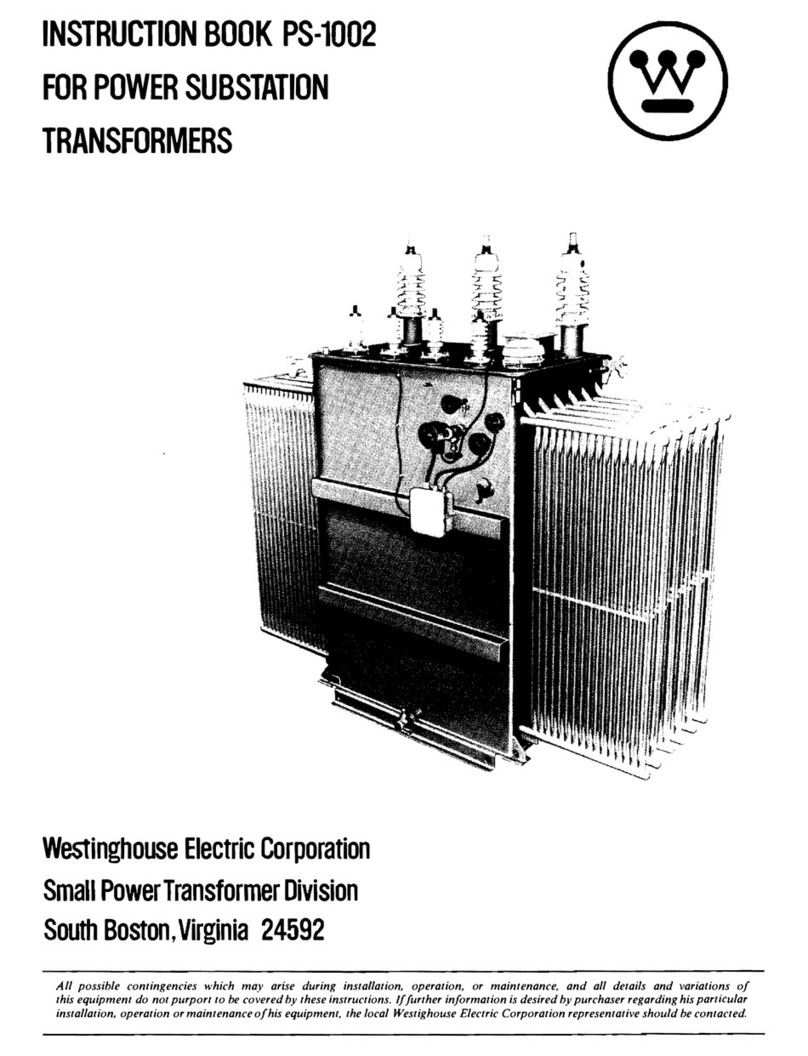
Westinghouse
Westinghouse PS-1002 Instruction book
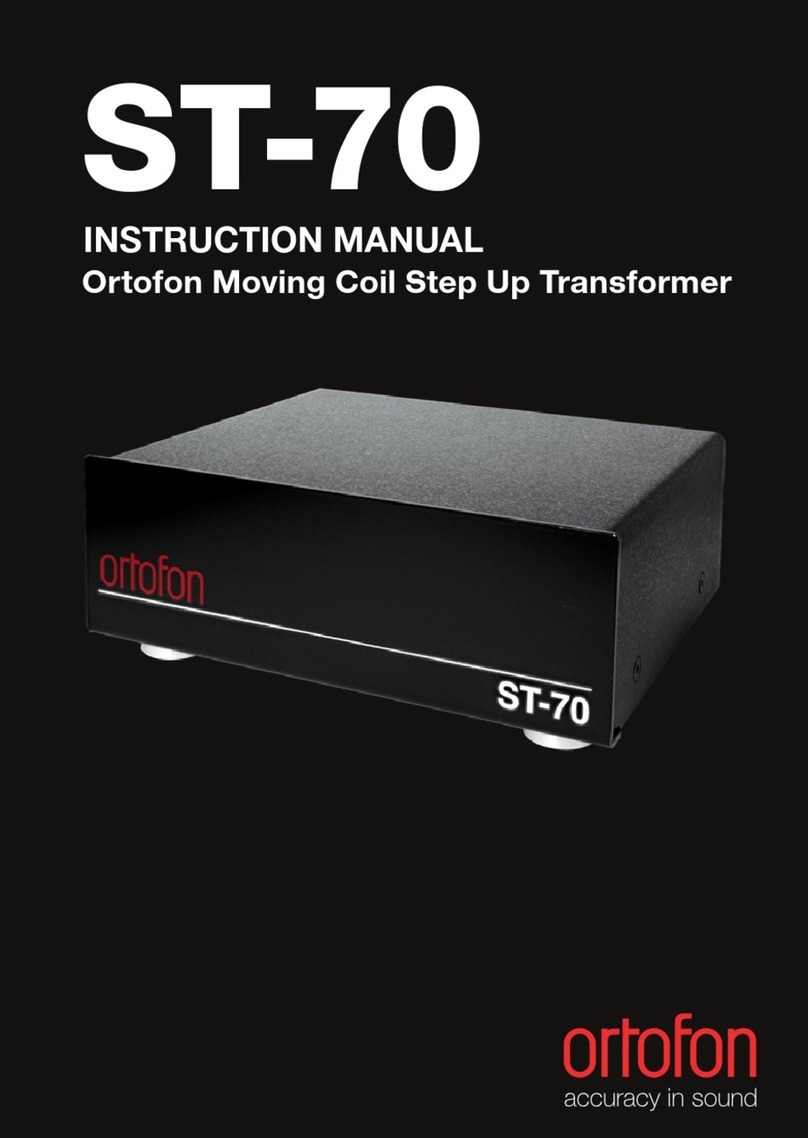
Ortofon
Ortofon ST-70 instruction manual
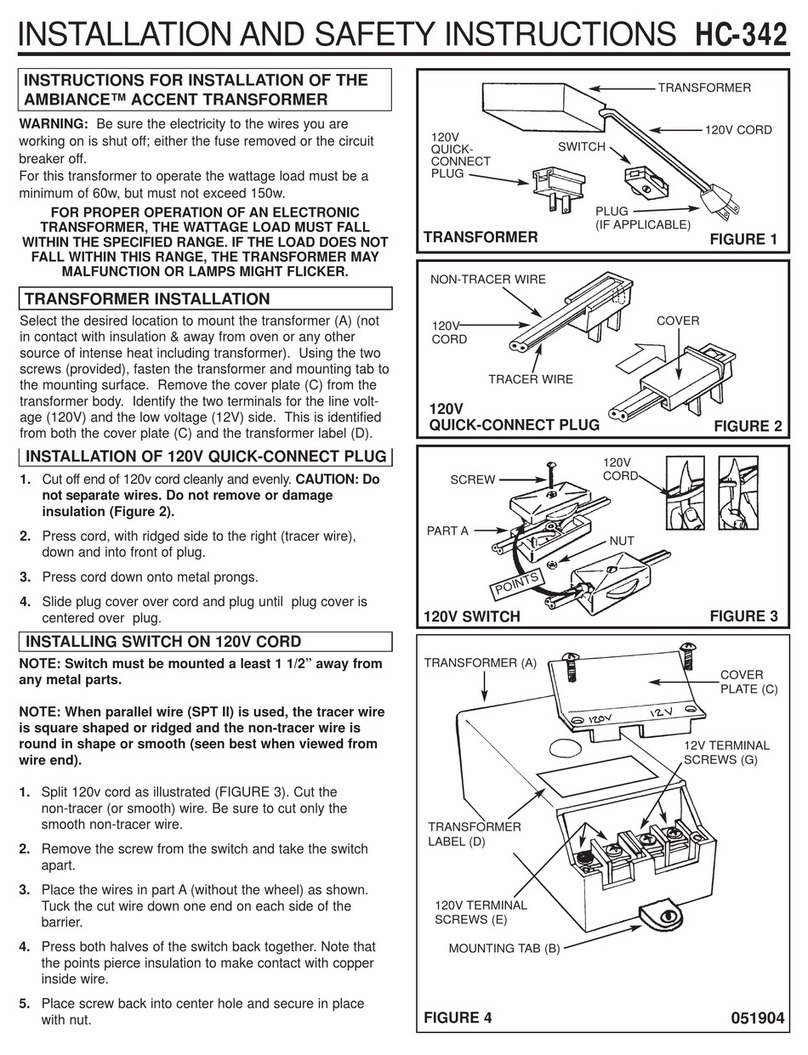
Sea gull lighting
Sea gull lighting AMBIANCE HC-342 Installation and safety instructions
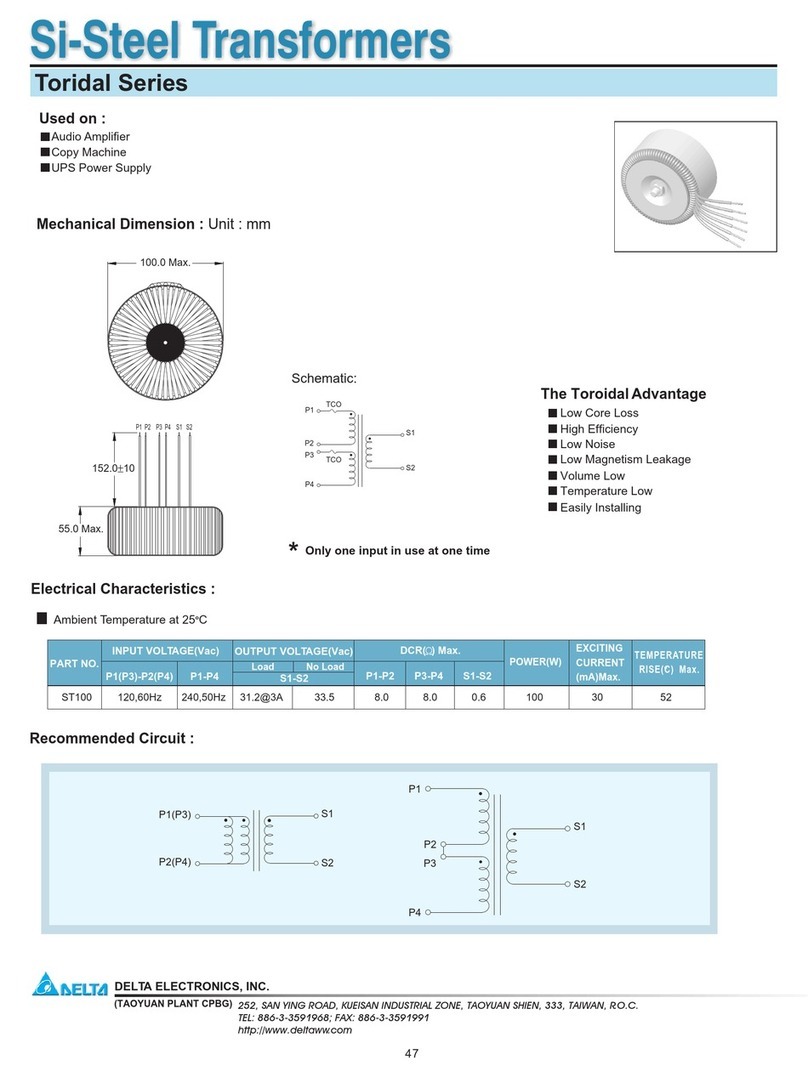
Delta Electronics
Delta Electronics Si-Steel Transformers Toridal Series Specification sheet
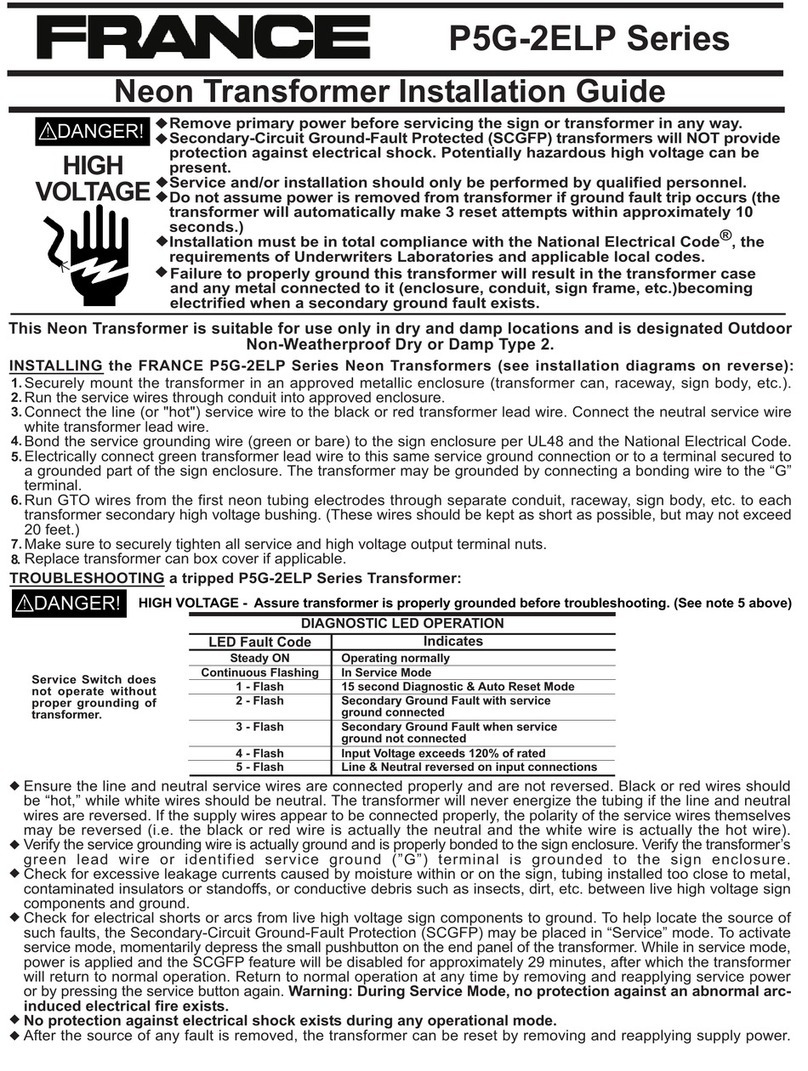
France
France P5G-2ELP Series installation guide
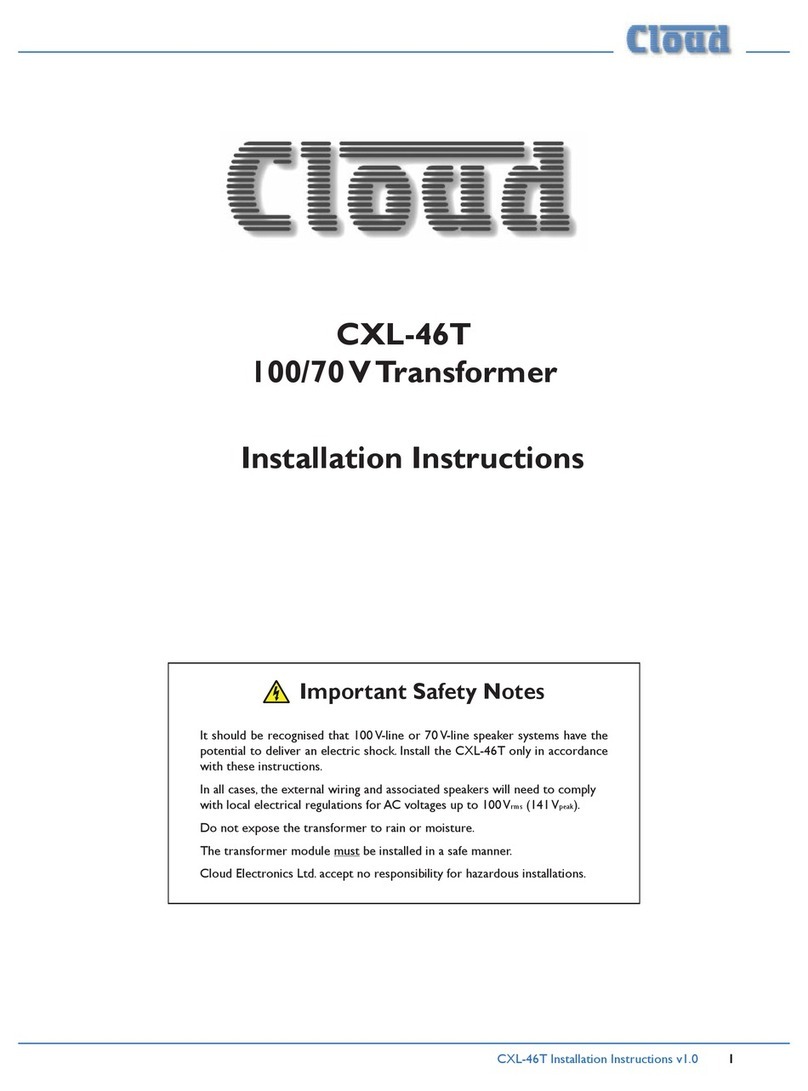
Cloud
Cloud CXL-46T installation instructions
